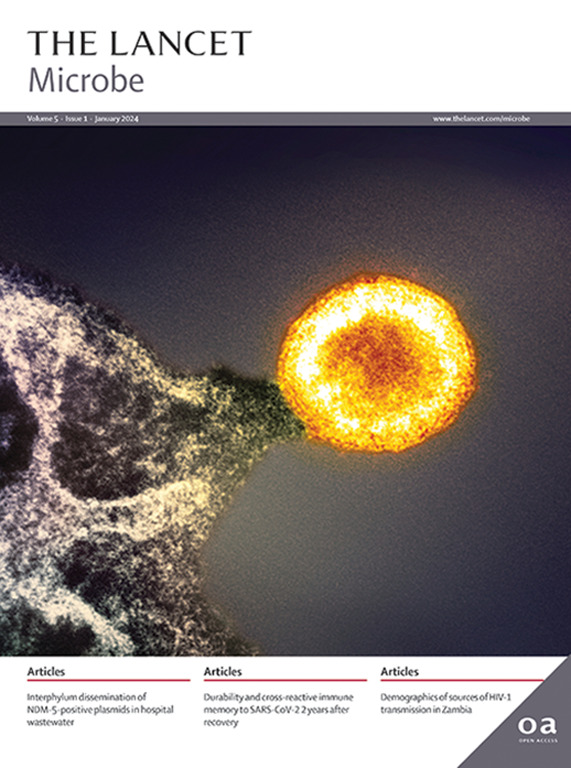在法国和瑞士的实体器官移植受者中,霉酚酸治疗与特定菌株感染的关系:一项多中心、回顾性、横断面研究。
IF 20.4
1区 生物学
Q1 INFECTIOUS DISEASES
引用次数: 0
摘要
背景:肺囊虫性肺炎(PCP)病例聚集性涉及实体器官移植(SOT)受者在世界范围内已有报道。霉酚酸是一种用于防止SOT受体排斥反应的免疫抑制剂,靶向肌苷5'-单磷酸脱氢酶(IMPDH)蛋白,已被假设对吉氏肺孢子虫施加选择性压力,IMPDH基因中的错义突变G1020A (Ala261Thr)可能是这种选择压力的标志。本研究的目的是验证SOT受体携带携带impdh基因突变的猪弧菌的假设,并感染特定的猪弧菌菌株。方法:在这项具有全国代表性的多中心横断面研究中,我们纳入了来自26个法国和一个瑞士二级卫生保健中心诊断为PCP的非SOT受者(对照组),无论移植器官如何,是否涉及PCP病例群,以及没有霉酚酸暴露的非SOT受者(对照组)。我们纳入了年龄在18岁或以上的患者,这些患者的档案中有足够数量和质量的氏弧菌DNA提取物。采用包括impdh基因分析在内的多位点序列分型方法对吉罗氏斑绦虫标本进行了鉴定。本研究的主要结果是检测到impdh基因中的G1020A (Ala261Thr)突变。通过多变量logistic回归来评估该突变与从医疗记录中检索到的以下变量之间的关系:年龄、PCP诊断时的霉酚酸暴露、参与PCP病例群、PCP预防和临床结果。结果:58例SOT受者(44例接受霉酚酸治疗)和59例非SOT受者(对照组;在2001年1月1日至2021年12月31日期间诊断为PCP的患者(未接受霉酚酸治疗)被纳入研究。在40例(68.9%)SOT受者(37例接受霉酚酸治疗)样本中检测到G1020A (Ala261Thr)突变,而在对照组患者样本中未检测到G1020A突变。多变量分析显示,以G1020A突变为特征的等位基因与PCP诊断时的霉酚酸暴露相关(校正优势比为73·61 [95% CI为17.41 -455·70];解释:本研究中的SOT受体主要感染了具有impdh基因突变的特定P jrovecii菌株,这可能具有选择优势,因为G1020A (Ala261Thr)和G1020T (Ala261Ser)都与其他真菌的霉酚酸抗性相关。霉酚酸选择压力可能解释了这些猪卟啉卟啉菌株在该患者群体中的维持和循环,因此它们可能参与PCP病例群。资助:法语移植协会和Chiesi。本文章由计算机程序翻译,如有差异,请以英文原文为准。
Association between mycophenolic acid treatment and infection with specific strains of Pneumocystis jirovecii in solid organ transplant recipients in France and Switzerland: a multicentre, retrospective, cross-sectional study
Background
Pneumocystis pneumonia (PCP) case clusters involving solid organ transplant (SOT) recipients have been reported worldwide. Mycophenolic acid, an immunosuppressant used to prevent rejection in SOT recipients that targets the inosine 5′-monophosphate dehydrogenase (IMPDH) protein, has been hypothesised to exert selective pressure on Pneumocystis jirovecii, with the missense mutation G1020A (Ala261Thr) in the impdh gene a possible marker of such selective pressure. The aim of this study was to test the hypothesis that SOT recipients harbour P jirovecii with mutations in the impdh gene and are infected with specific P jirovecii strains.
Methods
In this retrospective, multicentre, cross-sectional study of nationally representative, individual-level data, we included SOT recipients, regardless of the organ transplanted, involved or not in a PCP case cluster, and non-SOT recipients (control group) without mycophenolic acid exposure, diagnosed with PCP from 26 French and one Swiss secondary health-care centres. We included patients aged 18 years or older for whom archival P jirovecii DNA extracts were available in sufficient quantity and quality. P jirovecii specimens were characterised using a multilocus sequence typing method including impdh gene analysis. The primary outcome of this study was the detection of the G1020A (Ala261Thr) mutation in the impdh gene. A multivariable logistic regression was done to assess the relation between this mutation and the following variables retrieved from medical records: age, mycophenolic acid exposure at the time of PCP diagnosis, involvement in a PCP case cluster, PCP prophylaxis, and clinical outcome.
Findings
58 SOT recipients (44 treated with mycophenolic acid) and 59 non-SOT recipients (control group; not treated with mycophenolic acid) diagnosed with PCP between Jan 1, 2001, and Dec 31, 2021, were enrolled. The G1020A (Ala261Thr) mutation was detected in P jirovecii specimens from 40 (68·9%) SOT recipients (37 treated with mycophenolic acid) and in none of the P jirovecii specimens from the patients in the control group. The multivariable analysis showed that the allele characterised by the G1020A mutation was associated with mycophenolic acid exposure at the time of PCP diagnosis (adjusted odds ratio 73·61 [95% CI 17·41–455·70]; p<0·0001) and involvement in a PCP case cluster (12·77 [1·58–171·90]; p=0·029), whereas it was not associated with age, PCP prophylaxis, and clinical deterioration. A second missense mutation, G1020T (Ala261Ser) was identified in P jirovecii specimens from three SOT recipients (two treated with mycophenolic acid). Two specific multilocus genotypes (MLG-31 and MLG-34) of P jirovecii associated with Ala261Thr and Ala261Ser substitutions in IMPDH, respectively, were detected only in SOT recipients (38 patients with MLG-31 and three patients with MLG-34).
Interpretation
SOT recipients in this study were primarily infected with specific P jirovecii strains with mutations in the impdh gene, which might confer a selective advantage as both the G1020A (Ala261Thr) and G1020T (Ala261Ser) are associated with mycophenolic acid resistance in other fungi. Mycophenolic acid selective pressure might explain the maintenance and circulation of these P jirovecii strains within this patient population, and consequently their potential involvement in PCP case clusters.
Funding
French Speaking Society for Transplantation, and Chiesi.
求助全文
通过发布文献求助,成功后即可免费获取论文全文。
去求助
来源期刊

Lancet Microbe
Multiple-
CiteScore
27.20
自引率
0.80%
发文量
278
审稿时长
6 weeks
期刊介绍:
The Lancet Microbe is a gold open access journal committed to publishing content relevant to clinical microbiologists worldwide, with a focus on studies that advance clinical understanding, challenge the status quo, and advocate change in health policy.
 求助内容:
求助内容: 应助结果提醒方式:
应助结果提醒方式:


